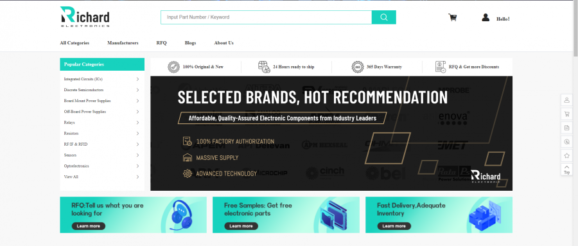Arduino Applications in Real-World Projects: Driving Innovation into Reality

Arduino Applications in Real-World Projects: Driving Innovation into Reality Arduino’s Versatility Shines in Real-World Projects, Enabling Endless Possibilities HONGKONG, CHINA, November 27, 2023 /EINPresswire.com/ — Driven by modern technology, Arduino, an open-source electronic prototyping platform, is continuously evolving and developing. Its flexibility, ease of use, and rich ecosystem make Arduino the preferred tool in various real-world projects. This article will provide a detailed overview of Arduino’s applications in the fields of smart homes and automotive electronics, showcasing how it drives reality through innovation. Smart homes leverage advanced technology and smart devices to enhance comfort, safety, and convenience. Arduino, as an open-source electronic prototyping platform, plays a crucial role in smart home applications. The following are several aspects of Arduino’s applications in smart homes: ·Intelligent Lighting Control: Arduino enables the construction of smart lighting control systems effortlessly. By leveraging Arduino’s sensors and actuators, automatic lighting adjustment and remote control can be achieved. For example, one can set timers for light switches, automatically adjust light intensity based on ambient light levels, or remotely control the lights through a mobile application. ·Smart Door Lock Systems: Arduino can be utilized to build smart door lock systems, enhancing home security. By connecting Arduino to electronic locks and sensors, features such as fingerprint recognition, password input, and remote unlocking can be implemented. This enables convenient access for household members while ensuring real-time monitoring of the lock’s status. ·Temperature and Humidity Monitoring: Arduino’s temperature and humidity sensors allow real-time monitoring of the home’s ambient conditions. Such monitoring is helpful for regulating indoor environments and energy conservation. For instance, when the temperature or humidity exceeds certain thresholds, Arduino can automatically activate air conditioning or dehumidifiers to provide a more comfortable living environment. ·Smart Outlets: By utilizing Arduino, traditional outlets can be transformed into smart outlets, enabling remote control and scheduled switching of electrical devices. Through the connection between Arduino and the outlet, users can remotely control the on/off state of the outlet and implement energy-efficient management of electrical devices via a mobile app or other smart devices. ·Security Monitoring: Arduino can be combined with various sensors to build a home security monitoring system. For example, by connecting smoke sensors, gas sensors, and door/window sensors, real-time monitoring of home security can be achieved. When smoke, gas leaks, or open doors/windows are detected, Arduino can trigger alarm systems and send notifications to household members. In summary, Arduino has a wide range of applications and creative potential in smart home environments. It provides a flexible and user-friendly platform that simplifies the construction and innovation of smart home systems. Through Arduino, we can achieve smarter, more convenient, and more comfortable living experiences. Whether for professionals or hobbyists, Arduino is a powerful tool for realizing various innovative smart home applications. Arduino also finds extensive applications in automotive electronics. It can be used to build various automotive electronic systems, enhancing vehicle performance, safety, and convenience. The following are detailed explanations of Arduino’s applications in automotive electronics: ·Vehicle Data Recording and Monitoring System: Arduino can be used to build vehicle data recording and monitoring systems that record and monitor real-time vehicle parameters and statuses. By connecting Arduino to sensors such as temperature sensors, pressure sensors, and speed sensors, parameters such as engine temperature, tire pressure, and vehicle speed can be monitored in real-time. Arduino processes and records these data for subsequent analysis and troubleshooting. ·In-Car Audio and Video Systems: Arduino can be utilized to build in-car audio and video systems, enabling high-quality audio and video playback. By connecting Arduino to audio modules, video modules, and touch screen displays, in-car audio systems and multimedia playback functions can be implemented. Arduino can control audio and video playback, volume adjustment, and integration with other in-car devices. ·Vehicle Security and Anti-Theft Systems: Arduino can be used to build vehicle security and anti-theft systems, enhancing vehicle security. By connecting Arduino to sensors such as acceleration sensors, light sensors, and infrared sensors, vehicle status and surrounding environments can be monitored in real-time. Arduino can trigger corresponding actions based on the sensor signals, such as alarms or automatic door locking, to prevent theft and protect vehicle security. ·Vehicle Remote Control Systems: Arduino can be utilized to build vehicle remote control systems, enabling remote control and management of the vehicle. By connecting Arduino to wireless modules such as Bluetooth or wireless network modules, Arduino can be connected to mobile applications or cloud platforms. Users can remotely control functions such as vehicle power, ignition, and window control through a mobile app or cloud platform. ·Vehicle Driver Assistance Systems: Arduino can be used to build vehicle driver assistance systems, providing auxiliary functions during driving. For example, by connecting Arduino to ultrasonic sensors, cameras, etc., vehicle surroundings and obstacles can be monitored in real-time. Arduino processes sensor data to provide driver assistance functions such as reverse parking radar and lane departure warnings, enhancing driving safety. Arduino has vast application prospects and creative potential in automotive electronics. It provides a flexible and user-friendly platform that simplifies the construction and innovation of automotive electronic systems. In conclusion, Arduino, as an open-source electronic prototyping platform, is driving innovation and practical applications in various fields. This article has provided an overview of Arduino’s applications in smart homes, automotive electronics, and medical devices. With advancing technology, we believe Arduino will continue to play a crucial role in more real-world projects. Its ease of use and flexibility allow anyone, whether professionals, makers, or hobbyists, to create astonishing projects and bring convenience and innovation to our lives. Jerry Richard Electronics Limited +86 173 2876 9062 email us here EIN Presswire does not exercise editorial control over third-party content provided, uploaded, published, or distributed by users of EIN Presswire. We are a distributor, not a publisher, of 3rd party content. Such content may contain the views, opinions, statements, offers, and other material of the respective users, suppliers, participants, or authors.
